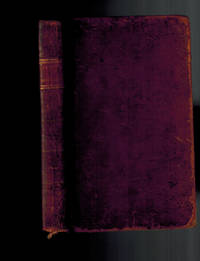
Nuclei and nerve tracts in the human brain – Noyaux et faisceaux du cerveau humain – Kerne und Faserbahnen des menschlichen Gehirns – Nuclei e vie nervose dell’encefalo umano. 50 photographs of macroscopic preparations from the Anatomical Institute, Basle.
by Eugen Ludwig and Josef Klingler
- Used
- Condition
- See description
- Seller
-
Tuebingen, Germany
Payment Methods Accepted
About This Item
Nuclei and nerve tracts in the human brain – Noyaux et faisceaux du cerveau humain – Kerne und Faserbahnen des menschlichen Gehirns – Nuclei e vie nervose dell'encefalo umano. 50 photographs of macroscopic preparations from the Anatomical Institute, Basle. Nancy, Georges Thomas, imprimeur-éditeur (1938). (4) leaves letterpress introductory matter, 50 photogravure prints (each measuring 235 x 152 mm) mounted within folded double sheets, each photogravure accompanied by a printed transparent overlay, and one leaf letterpress explanation in French, English, German and Italian. Loosely contained in publisher's half cloth portfolio with six ties, printed paper label to front cover. Front paste-down with mounted sheet of white paper with manuscript dedication by the two authors to Gerhard Wolf-Heidegger, dated "Basel, den 5. April 1939". Illustrated medical bookplate of Gerhard Wolf-Heidegger mounted below. Folio (320 x 238 mm). Spine-ends slightly rubbed.
Not in Heidtmann. Bibliographie der Photographie ; not in Hook/Norman ; not in Stanley Finger. Origins of Neuroscience. First edition of this portfolio with spectacular photogravures of the nuclei and nerve tracts in the human brain. The first studies of cerebral white matter were described by Galen and by the subsequent efforts of Vesalius on human cadaver specimens. The interest for the deep anatomy of the brain pushed anatomist during centuries to create and develop different techniques for specimen preparation and dissection in order to better reveal the complex white matter architectural organization. However, the biggest impact on the dissection of white matter anatomy was made by Joseph Klingler who developed a new method for specimens preparation and dissection. This technique became more feasible and widely used due to an increased quality of dissection and surprising quality of anatomical details. "During the 1930s, white matter tracts began to assume relevance for neurosurgery, especially after Cajal's work. In many reviews of white matter neurobiology, the seminal contributions of Josef Klingler (1888-1963) and their neurological applications have been overlooked. In 1934 at the University of Basel under Eugen Ludwig, Klingler developed a new method of dissection based on a freezing technique for brain tissue that eloquently revealed the white matter tracts. Klingler worked with anatomists, surgeons, and other scientists, and his models and dissections of white matter tracts remain arguably the most elegant ever created." (Abhishek Agrawal et.al. Josef Klingler's Models of White Matter Tracts. Influences on Neuroanatomy, Neurosurgery, and Neuroimaging. In: Neurosurgery vol. 69 (2011), pp. 238–254). The dedicatee Gerhard Wolf-Heidegger (1910-1986) emigrated to Basle in 1935 because of his Jewish descent, and became assistant at the anatomical institute, habilitated in 1937 and took over the professorial chair of anatomy as successor to Eugen Ludwig in 1955. A fine copy of a rare book.
Reviews
(Log in or Create an Account first!)
Details
- Bookseller
- Antiquariat Banzhaf
(DE)
- Bookseller's Inventory #
- 2208
- Title
- Nuclei and nerve tracts in the human brain – Noyaux et faisceaux du cerveau humain – Kerne und Faserbahnen des menschlichen Gehirns – Nuclei e vie nervose dell’encefalo umano. 50 photographs of macroscopic preparations from the Anatomical Institute, Basle.
- Author
- Eugen Ludwig and Josef Klingler
- Format/Binding
- Publisher’s half cloth portfolio with six ties, printed paper label to front cover
- Book Condition
- Used
- Quantity Available
- 1
- Publisher
- Georges Thomas, imprimeur-éditeur
- Place of Publication
- Nancy
- Date Published
- 1938
- Size
- Folio (320 x 238 mm)
- Weight
- 0.00 lbs
- Keywords
- neuroscience, white matter tract, photography
Terms of Sale
Antiquariat Banzhaf
About the Seller
Antiquariat Banzhaf
About Antiquariat Banzhaf
Glossary
Some terminology that may be used in this description includes:
- Bookplate
- Highly sought after by some collectors, a book plate is an inscribed or decorative device that identifies the owner, or former...
- Fine
- A book in fine condition exhibits no flaws. A fine condition book closely approaches As New condition, but may lack the...
- First Edition
- In book collecting, the first edition is the earliest published form of a book. A book may have more than one first edition in...
- Paste-down
- The paste-down is the portion of the endpaper that is glued to the inner boards of a hardback book. The paste-down forms an...
- New
- A new book is a book previously not circulated to a buyer. Although a new book is typically free of any faults or defects, "new"...
- Folio
- A folio usually indicates a large book size of 15" in height or larger when used in the context of a book description. Further,...
- Leaves
- Very generally, "leaves" refers to the pages of a book, as in the common phrase, "loose-leaf pages." A leaf is a single sheet...
This Book’s Categories
Also Recommended
-

Save 10% on every purchase!
Join the Bibliophiles’ Club and start saving 10% on every book.
$29.95 / Year






![Lectures on the Morbid Anatomy of the Serous and Mucous Membranes. Two volumes. [Volume I - On the serous membranes .Volume II, Part I - On the mucous membranes ]. {All published}.](https://d3525k1ryd2155.cloudfront.net/h/417/157/1297157417.0.m.jpg)
